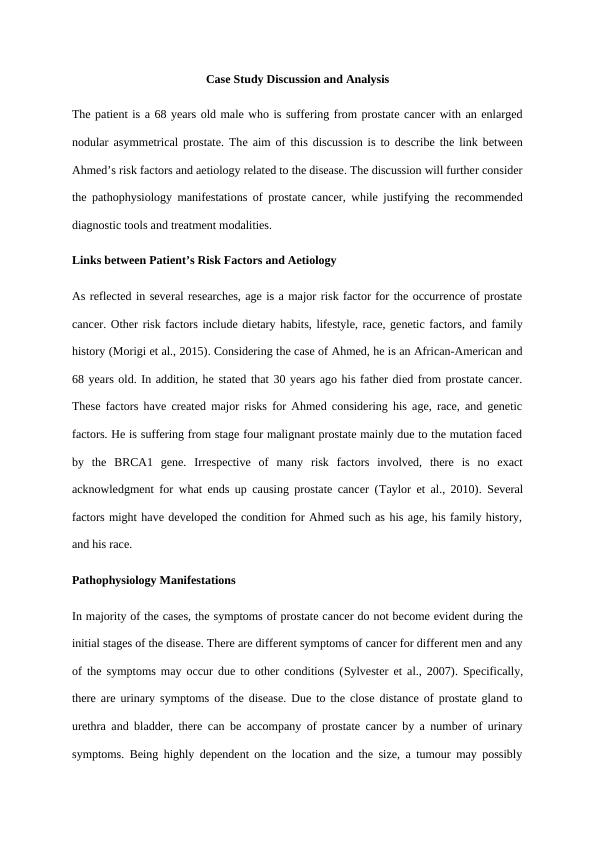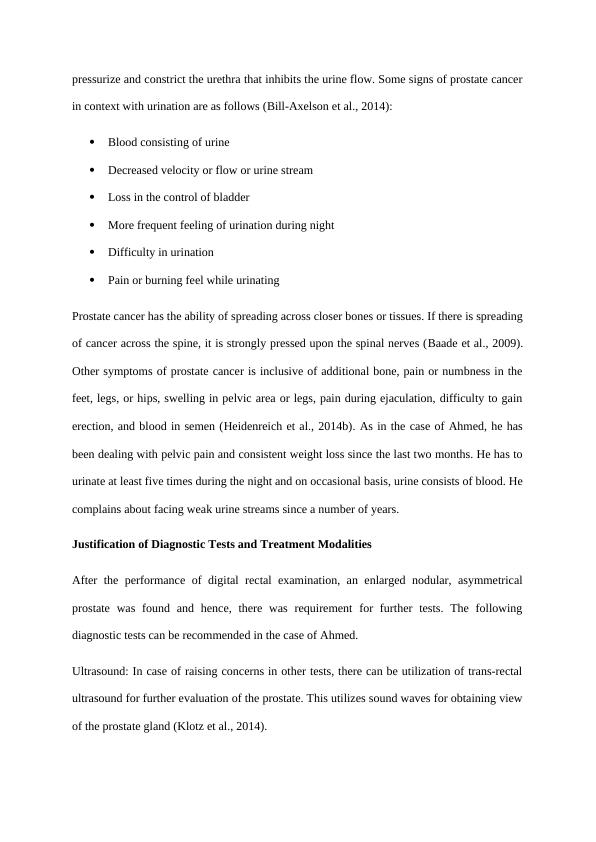Prostate Cancer: Risk Factors, Pathophysiology, Diagnostic Tests and Treatment Modalities
Added on 2023-06-14
5 Pages1566 Words393 Views
Case Study Discussion and Analysis
The patient is a 68 years old male who is suffering from prostate cancer with an enlarged
nodular asymmetrical prostate. The aim of this discussion is to describe the link between
Ahmed’s risk factors and aetiology related to the disease. The discussion will further consider
the pathophysiology manifestations of prostate cancer, while justifying the recommended
diagnostic tools and treatment modalities.
Links between Patient’s Risk Factors and Aetiology
As reflected in several researches, age is a major risk factor for the occurrence of prostate
cancer. Other risk factors include dietary habits, lifestyle, race, genetic factors, and family
history (Morigi et al., 2015). Considering the case of Ahmed, he is an African-American and
68 years old. In addition, he stated that 30 years ago his father died from prostate cancer.
These factors have created major risks for Ahmed considering his age, race, and genetic
factors. He is suffering from stage four malignant prostate mainly due to the mutation faced
by the BRCA1 gene. Irrespective of many risk factors involved, there is no exact
acknowledgment for what ends up causing prostate cancer (Taylor et al., 2010). Several
factors might have developed the condition for Ahmed such as his age, his family history,
and his race.
Pathophysiology Manifestations
In majority of the cases, the symptoms of prostate cancer do not become evident during the
initial stages of the disease. There are different symptoms of cancer for different men and any
of the symptoms may occur due to other conditions (Sylvester et al., 2007). Specifically,
there are urinary symptoms of the disease. Due to the close distance of prostate gland to
urethra and bladder, there can be accompany of prostate cancer by a number of urinary
symptoms. Being highly dependent on the location and the size, a tumour may possibly
The patient is a 68 years old male who is suffering from prostate cancer with an enlarged
nodular asymmetrical prostate. The aim of this discussion is to describe the link between
Ahmed’s risk factors and aetiology related to the disease. The discussion will further consider
the pathophysiology manifestations of prostate cancer, while justifying the recommended
diagnostic tools and treatment modalities.
Links between Patient’s Risk Factors and Aetiology
As reflected in several researches, age is a major risk factor for the occurrence of prostate
cancer. Other risk factors include dietary habits, lifestyle, race, genetic factors, and family
history (Morigi et al., 2015). Considering the case of Ahmed, he is an African-American and
68 years old. In addition, he stated that 30 years ago his father died from prostate cancer.
These factors have created major risks for Ahmed considering his age, race, and genetic
factors. He is suffering from stage four malignant prostate mainly due to the mutation faced
by the BRCA1 gene. Irrespective of many risk factors involved, there is no exact
acknowledgment for what ends up causing prostate cancer (Taylor et al., 2010). Several
factors might have developed the condition for Ahmed such as his age, his family history,
and his race.
Pathophysiology Manifestations
In majority of the cases, the symptoms of prostate cancer do not become evident during the
initial stages of the disease. There are different symptoms of cancer for different men and any
of the symptoms may occur due to other conditions (Sylvester et al., 2007). Specifically,
there are urinary symptoms of the disease. Due to the close distance of prostate gland to
urethra and bladder, there can be accompany of prostate cancer by a number of urinary
symptoms. Being highly dependent on the location and the size, a tumour may possibly

pressurize and constrict the urethra that inhibits the urine flow. Some signs of prostate cancer
in context with urination are as follows (Bill-Axelson et al., 2014):
Blood consisting of urine
Decreased velocity or flow or urine stream
Loss in the control of bladder
More frequent feeling of urination during night
Difficulty in urination
Pain or burning feel while urinating
Prostate cancer has the ability of spreading across closer bones or tissues. If there is spreading
of cancer across the spine, it is strongly pressed upon the spinal nerves (Baade et al., 2009).
Other symptoms of prostate cancer is inclusive of additional bone, pain or numbness in the
feet, legs, or hips, swelling in pelvic area or legs, pain during ejaculation, difficulty to gain
erection, and blood in semen (Heidenreich et al., 2014b). As in the case of Ahmed, he has
been dealing with pelvic pain and consistent weight loss since the last two months. He has to
urinate at least five times during the night and on occasional basis, urine consists of blood. He
complains about facing weak urine streams since a number of years.
Justification of Diagnostic Tests and Treatment Modalities
After the performance of digital rectal examination, an enlarged nodular, asymmetrical
prostate was found and hence, there was requirement for further tests. The following
diagnostic tests can be recommended in the case of Ahmed.
Ultrasound: In case of raising concerns in other tests, there can be utilization of trans-rectal
ultrasound for further evaluation of the prostate. This utilizes sound waves for obtaining view
of the prostate gland (Klotz et al., 2014).
in context with urination are as follows (Bill-Axelson et al., 2014):
Blood consisting of urine
Decreased velocity or flow or urine stream
Loss in the control of bladder
More frequent feeling of urination during night
Difficulty in urination
Pain or burning feel while urinating
Prostate cancer has the ability of spreading across closer bones or tissues. If there is spreading
of cancer across the spine, it is strongly pressed upon the spinal nerves (Baade et al., 2009).
Other symptoms of prostate cancer is inclusive of additional bone, pain or numbness in the
feet, legs, or hips, swelling in pelvic area or legs, pain during ejaculation, difficulty to gain
erection, and blood in semen (Heidenreich et al., 2014b). As in the case of Ahmed, he has
been dealing with pelvic pain and consistent weight loss since the last two months. He has to
urinate at least five times during the night and on occasional basis, urine consists of blood. He
complains about facing weak urine streams since a number of years.
Justification of Diagnostic Tests and Treatment Modalities
After the performance of digital rectal examination, an enlarged nodular, asymmetrical
prostate was found and hence, there was requirement for further tests. The following
diagnostic tests can be recommended in the case of Ahmed.
Ultrasound: In case of raising concerns in other tests, there can be utilization of trans-rectal
ultrasound for further evaluation of the prostate. This utilizes sound waves for obtaining view
of the prostate gland (Klotz et al., 2014).

End of preview
Want to access all the pages? Upload your documents or become a member.
Related Documents
History of Obesity Assignment Reportlg...
|8
|2315
|60
Clinical Case of Urinary Tract Infectionlg...
|7
|1958
|30
Management of Pain and Complications in Post-Operative Bladder Irrigationlg...
|11
|2491
|406
Case Study Analysis - Nursinglg...
|12
|2516
|30
Urinary Tract Infections in Older Persons- Reportlg...
|9
|2147
|231
NRSG258 Acute Care Nursing || ACUlg...
|9
|2293
|49
